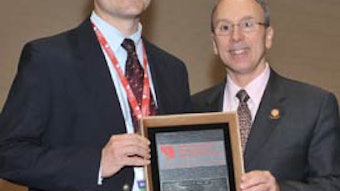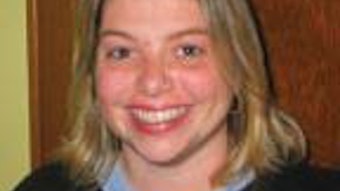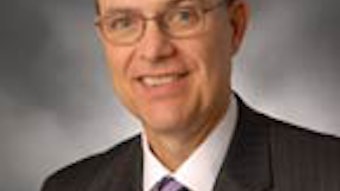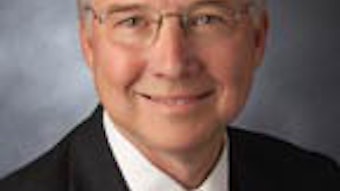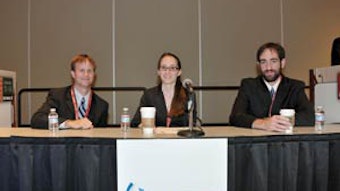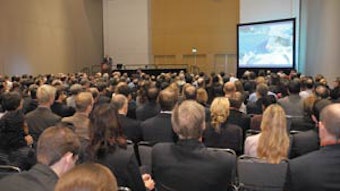2011 AAO-HNSF Annual Meeting & OTO EXPO Highlights
Ranked as one of the highest member benefits, more than 9,400 attendees and exhibitors flocked to the Annual Meeting & OTO EXPO in San Francisco, CA. The conference began the morning of Sunday, September 11, with a moment of silent tribute in honor of the 10-year anniversary of the victims of the September 11, 2001, attacks. The tribute took place during the Opening Ceremony for the attendees and concurrently in the OTO EXPO to allow our exhibitors time to acknowledge the day. This year’s Opening Ceremony included addresses from the AAO-HNS/F President J. Regan Thomas, MD, AAO-HNS/F EVP/CEO, David R. Nielsen, MD, and President-Elect, Rodney P. Lusk, MD. Marlee Matlin, Academy Award-winning actress and activist, delivered the John Conley Lecture on Medical Ethics to a captivated audience. At the conclusion of the Opening Ceremony, Dr. Thomas announced the opening of the OTO EXPO and led the attendees into the hall to witness the official ribbon cutting. Thousands of physicians, allied health professionals, and administrators then flooded the OTO EXPO to visit with device manufacturers and pharmaceutical companies, learn about the latest in waiting room solutions, discuss financial planning, locate an EMR/EHR company, and much more. The OTO EXPO featured nearly 300 companies whose products and services offer advice and solutions for otolaryngologists from the exam room to operating room. Over the course of the next four days, annual meeting attendees were exposed to a wide gamut of educational offerings. The annual meeting also featured four honorary guest lectures: The Cotton-Fitton Endowed Lecture in Pediatric Otolaryngology delivered by Lauren D. Holinger, MD; Eugene N. Myers International Lecture on Head and Neck Cancer presented by Professor Karl Hörmann, MD; Howard P. House, MD, Memorial Lecture for Advances in Otology delivered by Professor Vittorio Colletti, MD; and the Neel Distinguished Research Lecturepresented by James Christopher Post, MD, PhD. The Scientific Program was comprised of 88 miniseminars and featured almost 300 oral presentations. During their free time, attendees had a chance to explore the nearly 500 posters and later meet with the authors during the Tuesday night Poster Presentation Reception. Each afternoon, the Instruction Course program included more than 300 courses amounting to more than 393 hours of programming presented by the world’s leading experts in otolaryngology. AAO-HNS/F resident members were also able to enjoy more than 100 hours of complimentary instruction course programming. The evening events were full of excitement and entertainment for all. Sunday kicked things off with the President’s Reception featuring scrumptious food, music, and the chance to meet with friends and colleagues from around the world. The Tuesday receptions closed out the conference with Alumni Night followed by the International Reception with dancing. Both events provided yet another opportunity to network with friends and to make new acquaintances. As the annual meeting continues to evolve, several innovations were presented this year that increased engagement and productivity for the attendees. Annual Meeting & OTO EXPO mobile app. Continuing Education credit/evaluation mobile app. Expanded social media–Twitter, YouTube, LinkedIn, and Facebook. Improved delivery of online Instruction Course handouts. Planning for the 2012 Annual Meeting & OTO EXPO to be held September 9-12 in Washington, DC, is already under way. We will soon begin accepting applications for the Scientific Program (Oral & Poster Sessions) starting January 23, 2012, and running through February 20, 2012. For more information, visit our website at www.entnet.org/annual_meeting. Set to the backdrop of Washington, DC, next year’s Annual Meeting & OTO EXPO promises superior educational opportunities and continued innovation. We look forward to seeing you at the 116th Annual Meeting & OTO EXPO next fall.
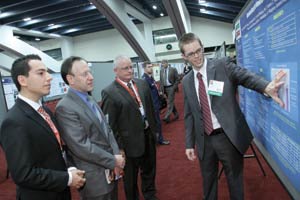 Attendees took in the nearly 500 posters on display.
Attendees took in the nearly 500 posters on display.Ranked as one of the highest member benefits, more than 9,400 attendees and exhibitors flocked to the Annual Meeting & OTO EXPO in San Francisco, CA. The conference began the morning of Sunday, September 11, with a moment of silent tribute in honor of the 10-year anniversary of the victims of the September 11, 2001, attacks. The tribute took place during the Opening Ceremony for the attendees and concurrently in the OTO EXPO to allow our exhibitors time to acknowledge the day.
This year’s Opening Ceremony included addresses from the AAO-HNS/F President J. Regan Thomas, MD, AAO-HNS/F EVP/CEO, David R. Nielsen, MD, and President-Elect, Rodney P. Lusk, MD. Marlee Matlin, Academy Award-winning actress and activist, delivered the John Conley Lecture on Medical Ethics to a captivated audience. At the conclusion of the Opening Ceremony, Dr. Thomas announced the opening of the OTO EXPO and led the attendees into the hall to witness the official ribbon cutting.
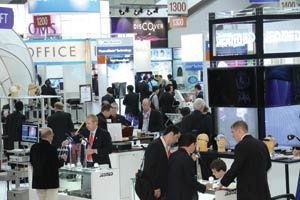 Nearly 300 companies participated in the OTO EXPO during the annual meeting.
Nearly 300 companies participated in the OTO EXPO during the annual meeting.Thousands of physicians, allied health professionals, and administrators then flooded the OTO EXPO to visit with device manufacturers and pharmaceutical companies, learn about the latest in waiting room solutions, discuss financial planning, locate an EMR/EHR company, and much more. The OTO EXPO featured nearly 300 companies whose products and services offer advice and solutions for otolaryngologists from the exam room to operating room.
Over the course of the next four days, annual meeting attendees were exposed to a wide gamut of educational offerings. The annual meeting also featured four honorary guest lectures: The Cotton-Fitton Endowed Lecture in Pediatric Otolaryngology delivered by Lauren D. Holinger, MD; Eugene N. Myers International Lecture on Head and Neck Cancer presented by Professor Karl Hörmann, MD; Howard P. House, MD, Memorial Lecture for Advances in Otology delivered by Professor Vittorio Colletti, MD; and the Neel Distinguished Research Lecturepresented by James Christopher Post, MD, PhD. The Scientific Program was comprised of 88 miniseminars and featured almost 300 oral presentations. During their free time, attendees had a chance to explore the nearly 500 posters and later meet with the authors during the Tuesday night Poster Presentation Reception.
Each afternoon, the Instruction Course program included more than 300 courses amounting to more than 393 hours of programming presented by the world’s leading experts in otolaryngology. AAO-HNS/F resident members were also able to enjoy more than 100 hours of complimentary instruction course programming.
 Educational sessions had standing room only.
Educational sessions had standing room only.The evening events were full of excitement and entertainment for all. Sunday kicked things off with the President’s Reception featuring scrumptious food, music, and the chance to meet with friends and colleagues from around the world. The Tuesday receptions closed out the conference with Alumni Night followed by the International Reception with dancing. Both events provided yet another opportunity to network with friends and to make new acquaintances.
As the annual meeting continues to evolve, several innovations were presented this year that increased engagement and productivity for the attendees.
- Annual Meeting & OTO EXPO mobile app.
- Continuing Education credit/evaluation mobile app.
- Expanded social media–Twitter, YouTube, LinkedIn, and Facebook.
- Improved delivery of online Instruction Course handouts.
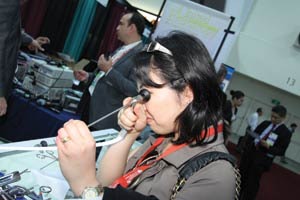 An attendee tries out a scope during the annual meeting.
An attendee tries out a scope during the annual meeting.Planning for the 2012 Annual Meeting & OTO EXPO to be held September 9-12 in Washington, DC, is already under way. We will soon begin accepting applications for the Scientific Program (Oral & Poster Sessions) starting January 23, 2012, and running through February 20, 2012. For more information, visit our website at www.entnet.org/annual_meeting.
Set to the backdrop of Washington, DC, next year’s Annual Meeting & OTO EXPO promises superior educational opportunities and continued innovation. We look forward to seeing you at the 116th Annual Meeting & OTO EXPO next fall.


